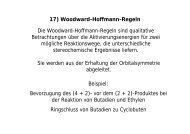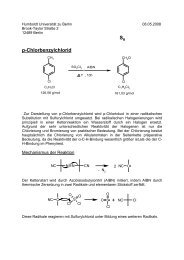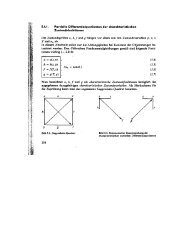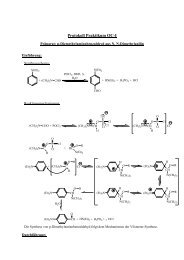Gas-Phase Reactions of Homo- and ... - Institut für Chemie
Gas-Phase Reactions of Homo- and ... - Institut für Chemie
Gas-Phase Reactions of Homo- and ... - Institut für Chemie
Create successful ePaper yourself
Turn your PDF publications into a flip-book with our unique Google optimized e-Paper software.
Helvetica Chimica Acta ± Vol. 88 (2005) 1417<br />
continuous ejection <strong>of</strong> [Co 2C 5H 7N] ‡ from the ICR cell a signal due to [Co 2C 8H 12N 2] ‡ is<br />
no longer observed.<br />
For FeCo ‡ , the secondary Reaction 38 is observed, which is absent for the reactions<br />
<strong>of</strong> the homonuclear cluster ion Fe ‡ 2 . Again, a double-resonance experiment proves that<br />
the product ion [FeCoC 6H 10N 2] ‡ originates from the reaction <strong>of</strong> [FeCoC 5H 7N] ‡ with<br />
pentanenitrile <strong>and</strong> is not due to a reaction <strong>of</strong> the initially formed encounter complex.<br />
FeCo ‡ <strong>and</strong> FeNi ‡ have in common that their primary dehydrogenation products react<br />
further with pentanenitrile (Eqns. 38 <strong>and</strong> 39). The secondary Reaction 40 <strong>of</strong><br />
[FeNiC 5H 7N] ‡ with pentanenitrile exhibits a formal relationship <strong>of</strong> this cluster ion<br />
with Reaction 13 <strong>of</strong> Ni ‡ 2 (Table 2). Obviously, the complexed cluster [FeNiC 5H 7N] ‡ is<br />
capable to bring about in a secondary, multi-step process formation <strong>of</strong> both H 2 <strong>and</strong><br />
HCN. Actually, also the reactions reported in Eqns. 37 ± 39 bear some resemblance to<br />
the primary reactions <strong>of</strong> Ni ‡ 2 with n-C 4H 9CN (Eqns. 13 <strong>and</strong> 14, Table 2, <strong>and</strong> Scheme 4).<br />
<strong>Reactions</strong> <strong>of</strong> MM' ‡ with Shorter Nitriles. The bond activation process <strong>of</strong> the shorter<br />
nitriles CH 3CN, C 2H 5CN, <strong>and</strong> n-C 3H 7CN are only observed for the Ni-containing<br />
clusters Ni ‡ 2 , FeNi ‡ , <strong>and</strong> CoNi ‡ (Table 5). The Ni-free clusters Fe ‡ 2 ,Co ‡ 2 , <strong>and</strong> FeCo ‡<br />
activate neither any C C nor C H bonds; only the formation <strong>of</strong> the adduct complex<br />
[MM'C 4H 7N] ‡ is observed in the reaction with the shorter butanenitrile. The higher<br />
reactivity <strong>of</strong> Ni ‡ 2 reported above for its reactions with pentanenitrile is also reflected in<br />
the behavior with the shorter butanenitrile as almost the same reaction channels are<br />
observed with both substrates, except that the combined elimination <strong>of</strong> H 2 <strong>and</strong> C 2H 4<br />
from pentanenitrile is replaced by the simple evaporation <strong>of</strong> C 2H 4 from butanenitrile.<br />
The additional Reaction 41 <strong>of</strong> Ni ‡ 2 with pentanenitrile, in which surprisingly atomic<br />
Ni ‡ is produced, is also observed for the shorter propanenitrile (Eqn. 48) as well as for<br />
ethanenitrile (Eqn. 52). With regard to thermochemical aspects, a straightforward<br />
explanation <strong>of</strong> these reactions is not at h<strong>and</strong>. While it is conceivable that the neutral<br />
product correspond to an inserted R Ni CN species which could help in improving<br />
the thermochemical deficit, up to now such a species has been neither observed nor<br />
considered in previous gas-phase or matrix-isolation studies [26]. Further, one has to<br />
consider that possibly long-lived excited states <strong>of</strong> Ni ‡ 2 are present, the existance <strong>of</strong><br />
which may account for the results as well (see Experimental).<br />
The crucial role <strong>of</strong> Ni in the chemistry <strong>of</strong> FeNi ‡ <strong>and</strong> CoNi ‡ is indicated by the<br />
similarity <strong>of</strong> the reactions <strong>of</strong> these clusters with the nitriles reported in Table 5. For<br />
example, dehydrogenation <strong>of</strong> n-C 3H 7CN is only observed for Ni ‡ 2 , FeNi ‡ , <strong>and</strong> CoNi ‡ ,<br />
<strong>and</strong> is completely absent in the reactions <strong>of</strong> Fe ‡ 2 ,Co ‡ 2 , <strong>and</strong> FeCo ‡ . For CoNi ‡ ,in<br />
comparison to FeNi ‡ , the similarity with Ni ‡ 2 is even more pronounced. In contrast to<br />
FeNi ‡ ,C C bond activation resulting in C 2H 4 evaporation occurs for the CoNi ‡ <strong>and</strong><br />
the Ni ‡ 2 clusters in their reactions with both n-C 3H 7CN <strong>and</strong> C 2H 5CN (Eqns. 45, 51, 60,<br />
<strong>and</strong> 63).<br />
Cluster Decomposition. Beside the similarities <strong>of</strong> the Ni-containing clusters Ni ‡ 2 ,<br />
FeNi ‡ , <strong>and</strong> CoNi ‡ with regard to their reactions with nitriles shorter than pentanenitrile,<br />
it is worth mentioning that cluster-ion decomposition in primary reactions with the<br />
alkanenitriles examined here are exclusively observed for these three metal-cluster<br />
cations; for the remaining clusters Fe ‡ 2 ,Co ‡ 2 , <strong>and</strong> FeCo ‡ metal ± metal bond cleavage<br />
only occurs in secondary reactions. These findings point to smaller bond energies<br />
between the two metal atoms in the Ni-containing clusters compared to Fe ‡ 2 ,Co ‡ 2 , <strong>and</strong>



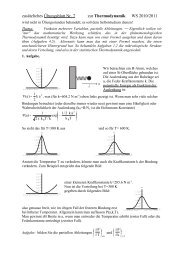
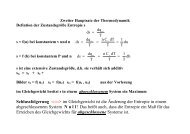
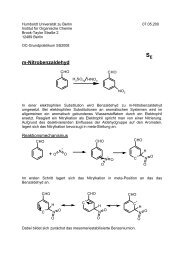
![Photoswitchable ionophores based on 1,3-alternate calix[4]arenes ...](https://img.yumpu.com/12290271/1/190x253/photoswitchable-ionophores-based-on-13-alternate-calix4arenes-.jpg?quality=85)
